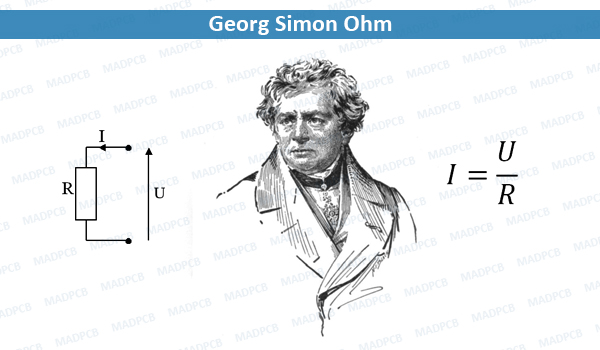What is Ohm?
The ohm (symbol: Ω) is the SI derived unit of electrical resistance, named after German physicist Georg Ohm (1789-1854). Various empirically derived standard units for electrical resistance were developed in connection with early telegraphy practice, and the British Association for the Advancement of Science proposed a unit derived from existing units of mass, length and time, and of a convenient scale for practical work as early as 1861. As of 2020, the definition of the ohm is expressed in terms of the quantum Hall effect.

Georg Simon Ohm
The ohm is defined as an electrical resistance between two points of a conductor when a constant potential difference of one volt, applied to these points, produces in the conductor a current of one ampere, the conductor not being the seat of any electromotive force.

Ohm Definition
in which the following units appear, volt (V), ampere (A), siemens (S), watt (W), second (s), farad (F), henry (H), joule (J), coulomb (C), kilogram (kg), and meter (m).
Following the 2019 redefinition of the SI base units, in which the ampere and the kilogram were redefined in terms of fundamental constants, the ohm is affected by a very small scaling in measurement.
In many cases the resistance of a conductor is approximately constant within a certain range of voltages, temperatures, and other parameters. These are called linear resistors. In other cases, resistance varies, such as in the case of the thermistor, which exhibits a strong dependence of its resistance with temperature.
A vowel of the prefixed units kiloohm and megaohm is commonly omitted, producing kilohm and megohm.
In alternating current circuits, electrical impedance is also measured in ohms.
Introduction of Georg Ohm
Georg Simon Ohm was a German physicist, best known for his “Ohm’s Law”, which states that the current flow through a conductor is directly proportional to the potential difference (voltage) and inversely proportional to the resistance. The physical unit of electrical resistance, the Ohm (symbol: Ω), was named after him.
Early Life and Education
Born on March 16 in 1789 in the university town of Erlangen, Bavaria, his younger brother Martin Ohm also became a famous mathematician. His father, Johann Wolfgang Ohm, was a locksmith and his mother Maria Elizabeth Beck, who died when Georg was ten years old, was the daughter of a tailor. Johann Ohm taught his children science and mathematics at home and Georg also attended Erlangen Gymnasium for four years. In 1805, at the age of fifteen Georg Ohm began studying at Erlangen University but he left after three semesters having spent much of his time enjoying himself dancing, ice skating and playing billiards and too little time on his studies.
Career Path
Ohm was then sent to Switzerland in 1806, accepting a position as a mathematics teacher in a school in Gottstadt. In 1809, Ohm became a private tutor in Neuchâtel, Switzerland. As well as his teaching obligations, he found time to continue his private study of mathematics.
In 1811, Ohm returned to Erlangen University earning a doctorate that same year, and then becoming a Privatdocent (an unsalaried teacher).
Ohm returned to school teaching in 1813, teaching mathematics and physics and writing a geometry textbook at a poor-quality school in Bamberg for three years. In 1817 he accepted a position at a Jesuit gymnasium in Cologne in 1817 and here he spent time carrying out physics experiments in the well-equipped laboratory. While here, he developed his important theory between the relationship of resistance, electric current and voltage.
In 1825, Ohm published his first paper which examined the decrease in the electromagnetic force produced by a wire as the length of the wire increased. It was not well received. Ohm published two more papers in 1826, and his famous book containing Ohm’s law, in 1827 in which he detailed his complete theory of electricity.
Resigning his teaching position in 1828, Ohm was without permanent employment until 1833 when he accepted a professorship at the Polytechnic School of Nuremberg, remaining there for sixteen years.
In 1849 he became curator of the Bavarian Academy’s physics cabinet at Munich, and in 1852 was appointed to the chair of physics at the University of Munich, a position he held until his death.
Contributions and Achievements
While teaching in Cologne, Ohm started passionately working on the conductivity of metals and the behavior of electrical circuits.
After extensive research, he wrote “Die Galvanische Kette, Mathematisch Bearbeitet” (The Galvanic Circuit Investigated Mathematically) in 1827, which formulated the relationship between voltage (potential difference), current and resistance in an electrical circuit:
I = V / R
The unit of current is the ampere (I); that of potential difference is the volt (V); and that of resistance is the ohm (Ω). This equation, as defined using the unit of resistance above, was not formalized until the 1860’s.
Ohms Law states that the current flow through a conductor is directly proportional to the potential difference (voltage) and inversely proportional to the resistance.
After initial criticism, most particularly by Georg Hegel, the noted creator of German Idealism, who rejected the authenticity of the experimental approach of Ohm, the “glory” finally came in 1841 when the Royal Society of London honored him with the Copley Medal for his extraordinary efforts. Several German scholars, including an adviser to the State on the development of telegraph, also recognized Ohm’s work a few months later.
The pertinence of Ohm’s Law was eventually recognized. The law still remains the most widely used and appreciated of all the rules relating to the behavior of electrical circuits.
Awards and Death
He received the Royal Society Copley medal in 1841.
Georg Ohm was made a foreign member of the Royal Society in 1842, and he became a full member of the Bavarian Academy of Sciences and Humanities in 1845.
Ohm died on July 6, 1854. He was 65 years old. The physical unit of electrical resistance, the Ohm (symbol: Ω), was named in his honor.
